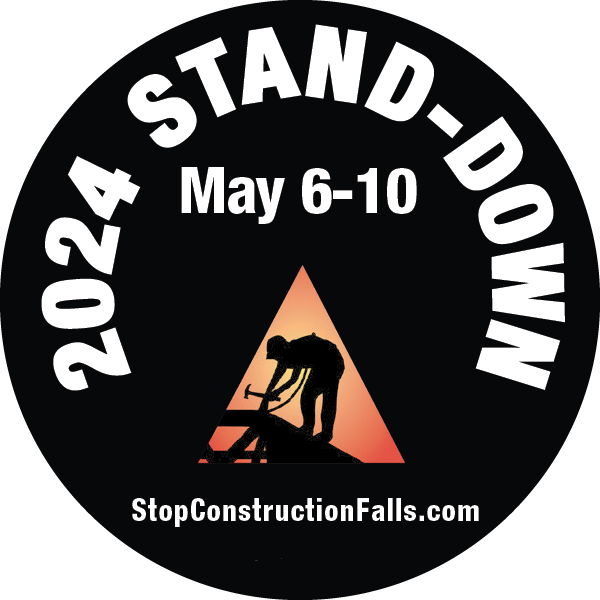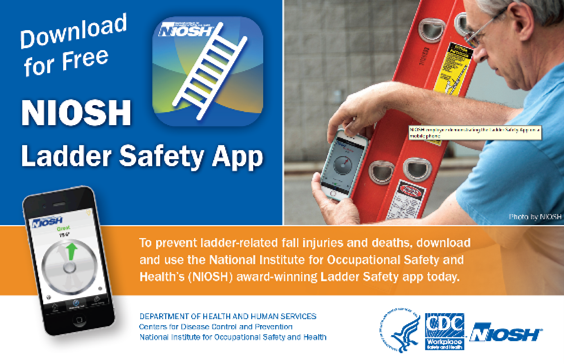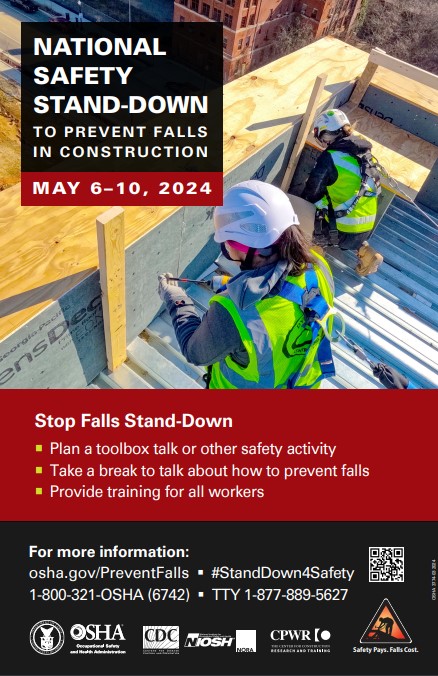The Problem of Falls from Elevation in Construction and Prevention Resources
Posted on by The Current Situation with Falls
The Current Situation with Falls
In 2022 falls from elevation represented approximately 81% of all fatal and 20% of all nonfatal slips, trips, and falls for all industry workers (BLS 2023a, BLS 2023b). Many of these falls occurred in the construction industry, and significantly impact construction employers, workers, and their families. In fact, construction workers made up nearly half (49%) of all fatal occupational slips, trips, and falls (BLS 2023). Since 2013, construction workers have suffered approximately 300 fatal and 20,000 nonfatal fall-related injuries per year (CPWR 2024). Four out of 10 of the Occupational Safety and Health Administration’s (OSHA) top citations involved falls, including general fall protection, ladders, scaffolding, and fall protection training.
Roofing contractors, residential building construction, and commercial/institutional building construction had the highest number of fatalities in 2022 compared to previous years and other industries (CPWR 2024). In addition, approximately 70% of all fatal falls in construction occurred to those working for employers with less than 10 employees (CPWR 2024).
Causes of Falls
The causes of construction workers’ falls from elevation are complex and multifaceted. There are many different factors at play. In 2021, CPWR conducted a fall experience survey that found that insufficient or ineffective planning is a key underlying cause of falls.
In addition, lack of planning was associated with reduced likelihood of using fall protection. Using fall protection was 71% lower for workers whose employer did not do any planning. Approximately half (49%) of survey respondents said that no fall protection was being used at the time of the fall. Lack of fall protection is particularly problematic for small residential construction firms with fewer than 10 employees (CPWR 2022).
Ladders and Ladder Safety
Falls from ladders are a common cause of injury for construction workers (CPWR 2024). Employers should be familiar with safety and regulatory requirements before using a ladder, including:
Planning work tasks to eliminate or reduce the need to work at elevation.
Providing the right equipment. This includes alternative equipment for extended work periods at elevation, such as aerial lifts, supported scaffolds, or mast climbing platforms. If a ladder must be used, properly select the ladder for the location and height of the task and the weight of the worker. Ensure it is thoroughly inspected before each use.
Training all workers in a language they understand on the proper use, care, and inspection of each type of ladder being used.
A recent webinar hosted by CPWR – The Center for Construction Research and Training (CPWR) discussed ladder safety and ways to improve ladder design, usage, and training. The webinar included a panel of experts who conduct laboratory research on ways to prevent common ladder fall injuries, such as slipping off a ladder and falling with the ladder. The audio from the webinar is also available in Spanish.
Ladder Safety Resources
National Ladder Safety Month website
ANSI blog on 5 most common causes of ladder incidents based on ALI study
OSHA Letter of Interpretation on three points of contact
Rescue Planning
Falls can occur quickly, even when all precautions are taken and using proper fall prevention and protection methods. Personal Fall Arrest Systems are a critical option to keep workers safe when performing tasks at heights, but rescue planning is essential.
If a fall occurs and a worker is suspended in a harness for more than a few minutes, a lack of circulation can cause unconsciousness, suspension trauma, and even death.
Every fall protection plan must include a rescue strategy to help workers after a fall and reduce fall-related injuries including suspension trauma even when using a Personal Fall Arrest System. Another finding from CPWR’s fall experience survey was that the odds of a fall being fatal were 76% lower for those who had self-rescue training compared to those who did not have this training. The rescue plan should be tailored to each jobsite and prioritize methods to preserve blood circulation for the worker. Ensure equipment for self-rescue is available, such as trauma straps and self-rescue harness units. The rescue plan should ensure other equipment is available, ready to be used, and in good condition, such as a ladder, aerial lift, or bucket truck.
Rescue Planning Resources
CPWR General Fall Protection Plan (English)
CPWR General Fall Protection Plan (Spanish)
OSHA Model Fall Protection Plan
OSHA Standard Interpretations – Rescue of a suspended worker following a fall event
CPWR Fall Rescue Planning Tipsheet
CPWR Fall Rescue Planning Tipsheet (Spanish)
The National Safety Stand-Down to Prevent Falls in Construction
The National Campaign to Prevent Falls in Construction (Falls Campaign) began in 2012 and was followed in 2014 by the National Safety Stand-Down to Prevent Falls in Construction (Stand-Down). The Falls Campaign idea originated with the National Occupational Research Agenda (NORA) Construction Sector Council. The Sector Council consists of industry experts on health and safety representing contractors, trade associations, labor, government, and academia. The National Institute for Occupational Safety and Health (NIOSH), OSHA, and CPWR are the Falls Campaign organizing partners. The Falls Campaign and Stand-Down are important events because of the high burden falls place on construction workers and their families.
Safety stand-downs originated in the military and are a time to focus on worker safety by stopping work and reinforcing the importance of fall prevention and fall protection.
This year’s Stand-Down will take place May 6-10, 2024. CPWR, NIOSH, and OSHA are hosting a virtual event on Tuesday May 7th at 2 pm (Eastern Time) to educate employers and crew leaders on how rescue planning can save lives. Click here to register and submit a question in advance. Attendees will learn more about identifying a competent person to lead fall prevention and rescue planning, incorporating key components of a rescue plan into the pre-job planning process, and using FREE resources and templates to tailor your plans to each unique jobsite. The webinar will be in English with simultaneous translation into Spanish available.
On May 8th at 2pm (Eastern Time) a second Stand-Down webinar presented entirely in Spanish will be hosted. Click here to register and submit a question in advance.
Hosting a Stand-Down
Thousands of companies have held fall safety stand-downs, reaching millions of workers across all 50 states and internationally. Industry and business leaders, universities, labor organizations, and community groups have all participated. In 2023, there were 3,554 stand-downs reaching more than 463,000 workers.
Construction employers and workers are invited to host a Safety Stand-Down or join one.
Your involvement can be as simple as sharing NIOSH, OSHA, or CPWR resources at your worksite. If you would like to host or join a free event that is open to the public, contact your Regional Stand-Down Coordinator. You can find resources to host a Stand-Down and activities at CPWR’s Promotion and Planning Page.
If you do participate in the Stand-Down, make sure you get a Certificate of Participation from OSHA. The certificates provide recognition for your event(s). After removing all personal information, CPWR used the data to evaluate and improve the Falls Campaign and Stand-Down every year. Previous evaluation reports and factsheets can be found on the Stop Construction Falls Evaluation page.
Stand-down Resources
CPWR’S Planning and Promotion Page on StopConstructionFalls.com
Suggestions to prepare successful Stand-Downs
Highlights from previous Stand-Downs
OSHA Regional Stand-Down Coordinators
OSHA Certificates of Participation
Additional Tools and Resources
National Falls Campaign & Safety Stand-Down Website
Bilingual Fall Hazards & Prevention YouTube Playlist
Spanish Fall Safety YouTube Playlist (Prevención de caídas)
Christina Socias-Morales, DrPH is a Research Epidemiologist in the NIOSH Office of Construction Safety and Health.
Scott Earnest, PhD, PE, CSP, is the Associate Director for the NIOSH Office of Construction Safety and Health.
Jessica Bunting, MPH, is the Research to Practice Director at the Center for Construction Research and Training (CPWR).
Rosa Greenberg, MPH, is a Research Analyst in Research to Practice at CPWR
Scott Breloff, Ph.D. is a Senior Biomechanical Research Engineer in the Division of Field Studies & Engineering and the Co-Coordinator for the Construction Program in the Office of Construction Safety and Health at NIOSH.
Asha Brogan, MS, is a Heath Communication Fellow in the NIOSH Division of Field Studies & Engineering.
Douglas Trout, MD, MHS, is Deputy Director, Office of Construction Safety and Health at NIOSH.
References
Bureau of Labor Statistics (2023a). News Release National Census of Fatal Occupational Injuries in 2022. USDL-23-2615. December 19, 2023. Available from: https://www.bls.gov/news.release/pdf/cfoi.pdf.
Bureau of Labor Statistics (2023b). Number of nonfatal occupational injuries and illnesses involving days away from work, restricted activity, or job transfer (DART), days away from work (DAFW), and days of restricted work activity, or job transfer (DJTR) by event or exposure leading to injury or illness and industry sector, private industry, 2021-2022 (TABLE R64). November 8, 2023. Available from: https://www.bls.gov/iif/nonfatal-injuries-and-illnesses-tables/case-and-demographic-characteristics-table-r64-2021-2022.xlsx
CPWR (2024). Data Bulletin: Fatal and Nonfatal Falls in the US Construction Industry. The Center for Construction Research and Training. Silver Spring, MD. March 2024. https://www.cpwr.com/wp-content/uploads/DataBulletin-March2024.pdf.
CPWR (2022). Underlying Causes of Falls from Heights (Highlighted Findings from a CPWR Survey). The Center for Construction Research and Training. Silver Spring, MD. March 2022. https://www.cpwr.com/wp-content/uploads/RR-falls_experience_survey.pdf.
Posted on by

